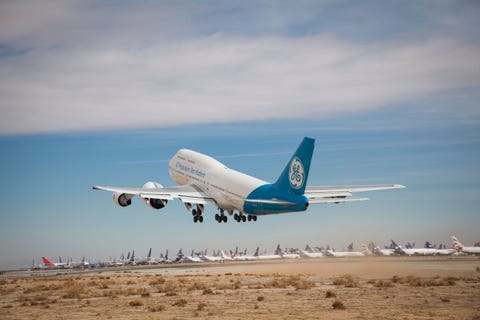Largest Jet Engine in the World Takes First Flight
The GE9X has entered flight testing on General Electric's 747 flying testbed.
By Jay Bennett

GE AVIATION
The biggest turbine engine in the world, nearly as wide as a Boeing 737 fuselage, took to the skies for the first time on Wednesday, March 14. The GE9X, destined to power the Boeing 777X, has a composite fan stretching 134 inches in diameter, more than 11 feet, tucked into a 14-and-a-half-foot nacelle. The engine is so big, it needs to be specially mounted on the wing to allow for enough ground clearance.
Though the GE9X is designed for the 777X, GE is flight testing the engine on a Boeing 747-400 flying testbed. Using an aircraft with four engines, only one GE9X, allows engineers to put the giant engine through the motions alongside engines with known performance envelops (GE CF6-80C2s).
The first flight with the GE9X lasted for more than four hours. The flight team completed the entire test checklist, evaluating a number of systems on the engine in preparation for future flights.
“The GE9X and Victorville teams have spent months preparing for flight testing of the engine, and their efforts paid off today with a picture-perfect first flight,” said Ted Ingling, general manager of the GE9X program, in a press release. “Today’s flight starts the beginning of the GE9X flight test campaign that will last for several months, allowing us to accumulate data on how the engine performs at altitude and during various phases of flight.”
The GE9X is in the 100,000 pound thrust class, making it one of the most powerful jet engines in the world (the record holder is the GE90, which hit 127,900 pounds of thrust in 2002). The high-bypass turbofan engine uses 16 composite fan blades. In preparation for the flight, GE removed six-foot wing extensions from the 747 to reduce the wingspan to just over 195 feet, stiffening the wing to support the weight of the giant engine.

GE AVIATION
GE has additional GE9X engines in different testing procedures, including one in Winnipeg, Canada, that recently completed icing tests and one in Peebles, Ohio, currently going through crosswind testing. Yet another GE9X is being prepared for the FAA 150-hour block test, slated for this year. The robust performance test requires GE to run the GE9X up to triple red-line conditions—maximum fan speed, maximum core speed, and maximum exhaust temperature.
The company has almost 700 GE9Xs on order, and plans to deliver the first pair of engines to Boeing for mounting on a 777X later this year. Boeing hopes to flight test the 777-9, the first aircraft in the 777X program, in early 2019.
No comments:
Post a Comment